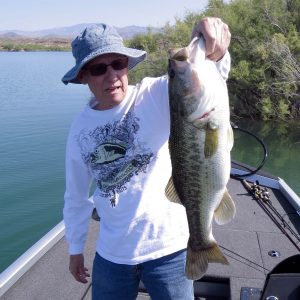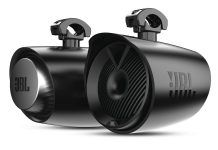Experts Jones And Duclos Offer ‘Big’ Advice
Giant worms are ideal baits for big fish at Lake Pleasant, especially at night. The man who introduced us to giant baits was Rich Jones, an Arizona fisherman who loved the Wednesday night tournaments and often took home a wad of cash. He actually used to pour his own giant baits – the Bullwhip was super big heavy worm.
Click here to see a list of AZ Lakes AZ Pros Stories on Western Outdoor Times.
Rich doesn’t make them anymore, but you can find giant worms like Mann’s Jelly Worms, Berkley Power Worms, and Zoom Magnum Ol’ Monster Worms in stores and online. Rich had seen an eight-pound bass thrashing on the surface of Lake Pleasant – it had a big white bass stuck in its throat. When he saw the size of the fish that bass was trying to eat, he decided his worms weren’t nearly big enough.
Big Fish, Big Baits

Jones isn’t the only angler who has made the connection between big fish and big baits, but not everyone has the patience to fish the lures correctly to catch big fish. Those who do soon earn a reputation for being big-bass fishermen, but the true trophy hunters are rarely tournament fishermen. “Tournament fishermen are going for a limit,” Jones explains, “whereas a trophy hunter can fish for hours without getting bit and not get too concerned about it. Fishing these big baits is very slow.”
Paul Duclos, a California angler who lays claim to over a hundred fish weighing more than ten pounds, agrees. Duclos is a big-bait fan, and he fishes a variety of big worms and swim baits in his favorite California waters. “I throw 2-foot worms as long as your leg,” he proclaims, “and I use swimbaits that weigh a pound.” These big baits do indeed produce big catches, but Paul really has to work for them.
Big Bass Live Deep
Duclos and Jones both agree that big bass usually live deep. Structure at depths of up to 50 feet may be where they spend the most time, but they come up shallower to feed. Duclos says most of his big fish are caught 18 to 25 feet deep. “Big bass cruise up into shallower water to feed, but they like to stay close to their deep water,” he says. Your best chance to catch these fish is when they are looking for food, so he concentrates on likely feeding areas very close to deep water, and fishes them for hours waiting for a big fish to come by and grab his lure.
Flat areas on points where two channels come together are ideal, as are humps that rise suddenly from deep water without breaking the surface. Such humps, if they are around 20 feet deep at the top, are seldom marked by buoys since they are not navigation hazards on most lakes.
They’re a gold mine. A clump of submerged trees, a rock pile, or even a single stump near this type of structure could be the home of a trophy bass. But the big bass prefer to eat big, says Duclos. They’ll cruise up, grab a big bite, then go back down to digest the meal. So you have to be willing to keep your big lure in their feeding area until they decide it’s time for lunch.
A Good Spot: Stay The Day
Giant worms are often so big that they require no weight. Sometimes a small bullet sinker used in front of the worm will help it get through submerged brush and over rocks. Duclos and Jones inch the worms through submerged brush, over feeding areas and in channels. Duclos has a rod holder on the back of his boat, and he often rigs up a big worm and lets it drag across the bottom as he drifts over a point while casting another big bait. But most of their time is spent fishing these worms extremely slowly across the bottom. He often double-anchors above a good spot and stays there all day.
“You don’t need to worry about not feeling the bite,” Duclos says. “A big bass will simply inhale the lure and keep on going.” You need a rod like a broomstick, he says, with just a little give in the tip. He uses 8- to 14-pound fluorocarbon line. Jones, on the other hand, often fishes big baits on spinning gear and likes the feel he gets from braided line. Either way, the ability to set the hook hard in deep water is something you need to keep in mind.
On Your Way To Trophy
Duclos likes to locate submerged trees along channels and swim the big worms through them slowly, giving them a slight twitch now and then to make their progress erratic. He also “stitches” worms along the bottom, using his fingers to take up line an inch or so at a time, keeping the lure in the strike zone as long as possible.
“Big bait, big fish.” How often have you heard that one? But just throwing a big bait doesn’t guarantee you a big bass. If you’re willing to take the time to find the right places and fish these huge plastics with agonizing slowness, you’re on your way to being a trophy bass fisherman.
Please scroll to the bottom of any article and leave us your outdoor experiences in the “Comments” section.
More Arizona Fishing Resources
Click here to see a list of AZ Lakes AZ Pros Stories on Western Outdoor Times.
Click here to see a list of AZ Lakes AZ Pros Stories on Arizona Boating And Watersports
Arizona Rivers And Streams Publishers Note
© 2005-2022 Arizona Boating & Watersports. All Rights Reserved.































